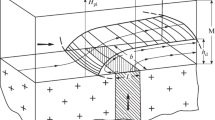Abstract
The computer simulation of the reorientation of the Earth and Mars lithosphere figure has been performed, which due to the dynamic redistribution of masses, allowed to reveal certain regularities of the structure-forming processes. It has been shown that the shape of the lithosphere surface has a different orientation relatively to the geoids’ (aroids) figure. This causes redistribution of masses leading to a strained state of the lithosphere as a result of endogenous and gravitational-rotational forces action in the evolutionary processes of planet’s self-development. The solution of this problem is considered on the example of lithosphere surface heights approximation by a biaxial ellipsoid with seven parameters. The acting horizontal forces in the upper shell of the planet has been calculated, introducing the concept of “evolutionary deviation of the plumb” and assuming that the tangential forces are proportional to the angle, which is defined as the angle between the direction of the plumb line in the past geological epoch and the plumb line direction at a given point. The calculated fields of tangential force vectors show good consistency with the direction of space-time displacement of Earth’s continents and tectonic plates and consistent with the results of the horizontal movements of GNSS stations. This is quite convincing evidence that under the long-term action of vortex rotationalgravitational forces, the lithospheres masses acquire the properties of creep. All this leads to the fact that interacting blocks and plates within the vortex rotational-gravitational model can be interconnected to elastic fields that creates a single planetary geodynamic field that forms the evolutionary state of the geo-environment.
Similar content being viewed by others
References
A. Wegener, The Origin of Continents and Oceans (F. Vieweg, Braunschweig, 1900; Nauka, Leningrad, 1984).
A. V. Vikulin, “A new type of elastic rotational waves in the geo-environment and vortex geodynamics,” Geodin. Tectonofiz. 1 (2), 119–141 (2010).
Geological History of the Territory of USSR and Plate Tectonics (Nauka, Moscow, 1989) [in Russian].
A. V. Dolitskii, Formation and Transformation of Tectonic Structures (Nedra, Moscow, 1985) [in Russian].
V. N. Zharkov, Interior Structure of the Earth and Planets (Nauka, Moscow, 1978; Harwood, Chur, 1985).
I. V. Karpenko, “Synergetic tectonics. 1. The physical nature of global cycles,” Geofiz. Zh. 34 (5), 60–71 (2012).
S. W. Carey, Theories of the Earth and Universe (Stanford Univ. Press, Stanford, 1988; Mir, Moscow, 1991).
L. A. Maslov, Geodynamics of Lithosphere of the Pacific Mobile Belt (Dal’nauka, Khabarovsk, 1986) [in Russian].
H. W. Menard, Marine Geology of the Pacific (McGraw-Hill, New York, 1964; Mir, Moscow, 1966).
G. A. Meshcheryakov and A. L. Tserklevich, Gravitational Field, Shape and Internal Structure of Mars (Naukova Dumka, Kiev, 1987) [in Russian].
New Global Tectonics (Mir, Moscow, 1974) [in Russian].
A. V. Peive, “Tectonics and magmatism,” Izv. Akad. Nauk SSSR. Ser. Geol., No. 3, 36–54 (1961).
Rotational Processes in Geology and Physics, Ed. by E. E. Milanovskii (KomKniga, Moscow, 2007) [in Russian].
O. I. Slenzak, Vortex Systems of the Lithosphere and the Precambrian Structure (Naukova Dumka, Kiev, 1972) [in Russian].
K. F. Tyapkin and M. M. Dovbnich, New Rotational Hypothesis of Structure Formation and Its Geological-Mathematical Substantiation (Noulidzh, Donetsk, 2009) [in Russian].
V. E. Hain, “Constructing a truly global model of Earth’s dynamics: Basic principles,” Geol. Geofiz. 51, 753–760 (2010).
A. L. Tserklevych, “Correlation analysis of gravitational field and topography of terrestrial planets,” Geodinamika, No. 1, 11–20 (2013).
A. L. Tserklevych and O. S. Zayats’, “Geodynamic evolution of the shapes of Earth and Mars,” Geodinamika, No. 2, 38–42 (2012).
A. Tserklevych, O. Zayats’, and S. Shilo, “Approximation of the physical surface of the Earth by biaxial and triaxial ellipsoids,” Geodinamika, No. 1, 40–49 (2016).
A. L. Tserklevych, O. S. Zayats, and Ye. O. Shilo, “Dynamics of the Earth shape transformation,” Kinematics Phys. Celestial Bodies 33, 130–141 (2017).
R. Blakey, Global Paleogeography. https://www2.nau.edu/rcb7/globaltext2.html.
E. L. Geist, J. R. Childs, and D. W. Scholl, “The origin of summit basins of the Aleutian Ridge: Implications for block rotation of an arc massif,” Tectonics 7, 327–341 (1988).
A. C. Maloof, G. P. Halverson, J. L. Kirschvink, et al., “Combined paleomagnetic, isotopic, and stratigraphic evidence for true polar wander from the Neoproterozoic Akademikerbreen Group, Svalbard, Norway,” Geol. Soc. Am. Bull. 118, 1099–1124 (2006).
A. Nur, H. Ron, and O. Scotti, “Fault mechanics and the kinematics of block rotation,” Geology 14, 746–749 (1986).
Author information
Authors and Affiliations
Corresponding author
Additional information
Original Russian Text © A.L. Tserklevych, O.S. Zayats, Ye.O. Shylo, O.M. Shylo, 2018, published in Kinematika i Fizika Nebesnykh Tel, 2018, Vol. 34, No. 1, pp. 30–56.
The article was translated by the authors.
About this article
Cite this article
Tserklevych, A.L., Zayats, O.S., Shylo, Y.O. et al. Generation of the Stressed State of the Lithosphere of the Earth and Mars Caused by the Reorientation of Their Figures. Kinemat. Phys. Celest. Bodies 34, 19–36 (2018). https://doi.org/10.3103/S0884591318010051
Received:
Published:
Issue Date:
DOI: https://doi.org/10.3103/S0884591318010051



